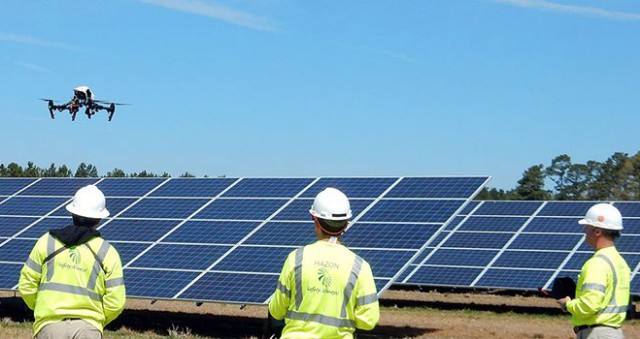is the largest electric company in the U.S., delivering electricity to about 7 million customers in the Southeast and Midwest. More and more of that electricity is being generated by renewable technologies. The utility owns more than 1,700 MW of generating capacity through 15 wind farms and 17 solar farms in 12 states.
Inspecting all those assets can be a daunting task, however, taking a few days to walk through just one 5 MW solar field, for example; or having to repel with ropes from a wind turbine hundreds of feet in the air to inspect blades.
When Duke Energy initiated a drone project in August 2014, the utility had augmented safety and improved operational excellence in mind for all its assets. Though Duke’s first pilot project was at its Marshall steam plant in August 2015, early interest in the use of the small unmanned aerial system (sUAS) came particularly from the utility’s commercial renewables group for inspecting solar and wind farms. Duke’s first solar farm inspection was in February 2016, with the first wind farm inspection coming a month later. By summer of 2016, more solar farm inspections were being added to the rotation, and Duke now has about 30 sUAS in operation.
Use of the drones has had a tremendous impact on Duke’s regular inspections of its solar farms, the larger of which have hundreds of thousands of photovoltaic panels to inspect, said Jason Handley, director of smart grid emerging tech and operations for Duke Energy.
“As soon as you put an infrared camera on a drone, what used to take three days takes two hours instead,” he said, presenting the utility’s sUAS initiative during a presentation at this year’s ARC Industry Forum in Orlando, Fla. “Besides the relative speed of flying over vs. walking among the solar panels, an infrared camera can quickly identify a failed cell or diode because it shows as white when it’s not generating electricity.”
The sUAS have been a boon in wind turbine inspections as well, where visual imaging can quickly and easily identify damaged blades caused by bird or lightning strikes. The drone technology has the potential to provide faster, safer and more effective inspection compared with other types of inspection, such as rope access, in which technicians hang from ropes a couple hundred feet in the air; or ground inspection with high-powered telescopes.
A challenge, however, has come from processing all the image data, Handley noted.
“If you’re taking individual still pictures, you have to piece them all together,” he said of the solar farm inspections. Duke has been using Pix4Dmsapper Pro for Orthomosaic to map the video that’s been taken. “We spend a tremendous amount of time looking at video.”
Drone inspections are still significantly faster than traditional methods. But Duke Energy is nonetheless looking forward to making use of artificial intelligence (AI) technologies to better process and map still and video images in a shorter amount of time.
“If we can make this work with AI to see where things are failing, it’s going to be a lot better for us going forward,” Handley said.
Source: Automation World


